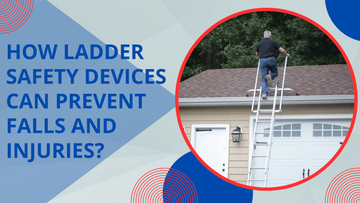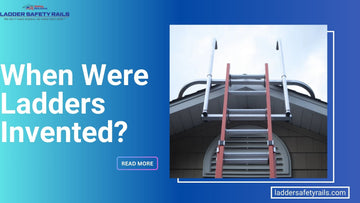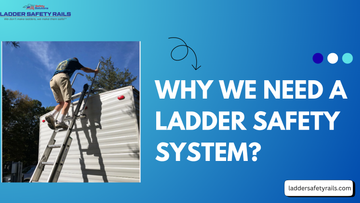
Using a ladder might seem straightforward, but the reality is, even a small mistake can lead to serious injury. If you're doing repairs, painting, or tackling everyday tasks that require a bit of height, stability matters more than we often realize.
That’s where ladder safety devices make a difference. Designed to keep ladders steady and secure, these tools help prevent slips, falls, and unexpected accidents.
In this guide, we’ll look at how the right safety equipment can add an essential layer of protection—so every climb is a confident one.
Why do Ladder Falls Happen So Often?
They often happen when people are in a hurry or think they’re only going up “for a second.” Those seconds can turn into serious injuries—or worse. Whether it's because the ladder slipped, the base was uneven, or someone reached a little too far to the side, falling from a ladder usually comes down to preventable mistakes.
Add in things like improper ladder angles, weather conditions, or unstable surfaces, and it’s a recipe for disaster. That’s where the right ladder stability device comes in. It adds that extra layer of security between you and a potential emergency room visit.
The Role of Ladder Safety Devices in Preventing Accidents
So, what exactly are ladder safety devices and why do they matter so much? Think of them as tools that help keep ladders steady and climbers secure. From stabilizers that prevent side tipping, to harnesses and lifelines that catch you if you fall, these tools are designed to give you confidence and control while you work.
A ladder safety system for fixed ladders might include a cage or a rail system to prevent falls. On a mobile ladder, it could be a top tie-off anchor and a base stabilizer. These systems can literally stop a fall mid-air if something goes wrong. That’s a huge deal.
When you're properly equipped with ladder fall protection, you don’t have to second-guess every move you make. That peace of mind is priceless.
Understanding OSHA Ladder Fall Protection Standards
OSHA ladder fall protection rules state that when you’re using fixed ladders that rise over 24 feet, you’re required to have some form of fall protection. That could be a cage, or a personal fall arrest system. And as of recent updates, cages are no longer considered sufficient for new ladders installed after 2018.
Failing to meet OSHA standards doesn’t just risk injury—it can result in hefty fines and legal trouble. So, if you're climbing anything higher than a kitchen step stool, make sure you follow the rules.
Common Injuries from Falling Off a Ladder—and How to Avoid Them

You’re 10 feet off the ground, reaching over to grab that one last shingle or cut that final branch. Suddenly, the ladder shifts. You lose balance. The next thing you know, you’re on the ground wondering if your wrist is broken. Unfortunately, it's a story we hear too often.
Falling of ladder injuries commonly include fractures (especially in the arms, wrists, or ankles), head trauma, spinal injuries, and internal damage. Even from as little as 6 feet, a fall can land you in the hospital for weeks. That’s why fall protection on ladders is critical—even for short jobs.
Avoiding these injuries starts with basic precautions. Always use non-slip footwear, inspect the ladder for damage, and never stand on the top rung. But even more importantly, use the right ladder safety device for your setup. They’re designed to catch mistakes before they turn into injuries.
When Is Fall Protection Needed on Ladders?
According to OSHA, for fixed ladders that are more than 24 feet tall, a personal fall arrest system (or ladder safety system) is required. But let’s not just go by regulations. If you’re high enough that a fall could hurt, you—and that’s usually anything over 6 feet—it’s time to start thinking seriously about securing ladders and using protective equipment.
Best Practices for Ladder Safety and Fall Prevention
Want to know the best way to prevent falling from a ladder? It’s not just using gear—it’s building good habits. Here’s a checklist of solid safety practices you should follow every single time:

-
Inspect before every use: Check for loose rungs, cracks, or missing feet. If something looks off, don’t climb it.
-
Use a ladder safety system: Whether it’s a harness, a stabilizer, or a lifeline, use what the job calls for.
-
Three points of contact: Always keep two hands and one foot, or two feet and one hand, on the ladder.
-
Watch the angle: The base should be 1 foot out for every 4 feet of height.
-
Avoid overreaching: Move the ladder instead. It takes 10 extra seconds and could save your life.
-
Don’t climb in bad weather: Wet rungs and high winds are a dangerous combo.
How to Properly Secure Your Ladder for Maximum Safety?
It is important to secure your ladder whenever feasible because even the best ladder can become a hazard if it's not anchored properly. Always secure both the top and bottom if possible. On uneven surfaces, use adjustable feet or ladder levelers. Avoid placing the ladder near doors, clutter, or high-traffic areas where someone might accidentally knock it over.
Add a ladder stability device like a stabilizer at the top or a non-slip base to boost security. If you’re on a roof, tie the ladder off to the gutter brackets using strong straps or hooks. When working with a fixed ladder, make sure a fall protection ladder system like a vertical lifeline or cable sleeve is in place. These precautions are small steps that make a big impact.
Conclusion
Falls from ladders are one of the most common—and preventable—workplace and home accidents. Investing in the right ladder safety devices isn’t just about following guidelines; it’s about creating a safer, more stable working environment.
Equip your ladder with Ladder Safety Rails durable Ladder Stabilizers, built to provide rock-solid support, reduce side-to-side movement, and help prevent dangerous falls.
Visit us and shop now and make every climb safer.
FAQs:
-
Is it important to secure your ladder whenever feasible?
Yes, prevent slipping, tipping, or sudden collapses that could lead to serious injuries. A good ladder safety device like a stabilizer or tie-off can stop small shifts from becoming big problems.
-
At what height does a ladder require a vertical lifeline?
Per OSHA regulation on fall protection, vertical lifelines are required for fixed ladders over 24 feet high. If the ladder is new, a cage alone is no longer compliant—it must have a personal fall arrest or safety system.
-
What are the main safety precautions when using ladders?
Always inspect your ladder, maintain three points of contact, use a ladder safety system, avoid bad weather, and never overreach. Also, make sure the ladder is placed on a stable surface and tied off when possible.
-
What are the examples of ladder safety system?
These include ladder stability devices, cages, harnesses, vertical lifelines, tie-off anchors, and personal fall arrest systems. They’re all designed to prevent injuries from falling from a ladder—each tailored to specific scenarios.
-
What is the safest way of securing a ladder?
The safest method is to anchor it at both the base and the top. Use ladder safety devices like standoff stabilizers, tie-down straps, or anchor points. The ladder should be level, angled properly, and never rest on fragile or unstable surfaces.
Read More Blogs Here:

Understanding OSHA Ladder Standards & Inspection Requirements




